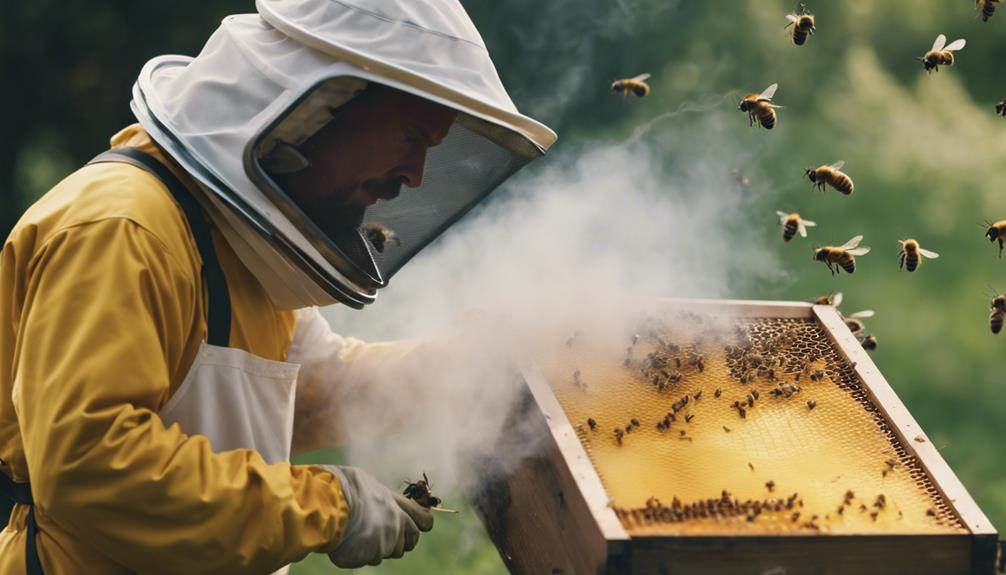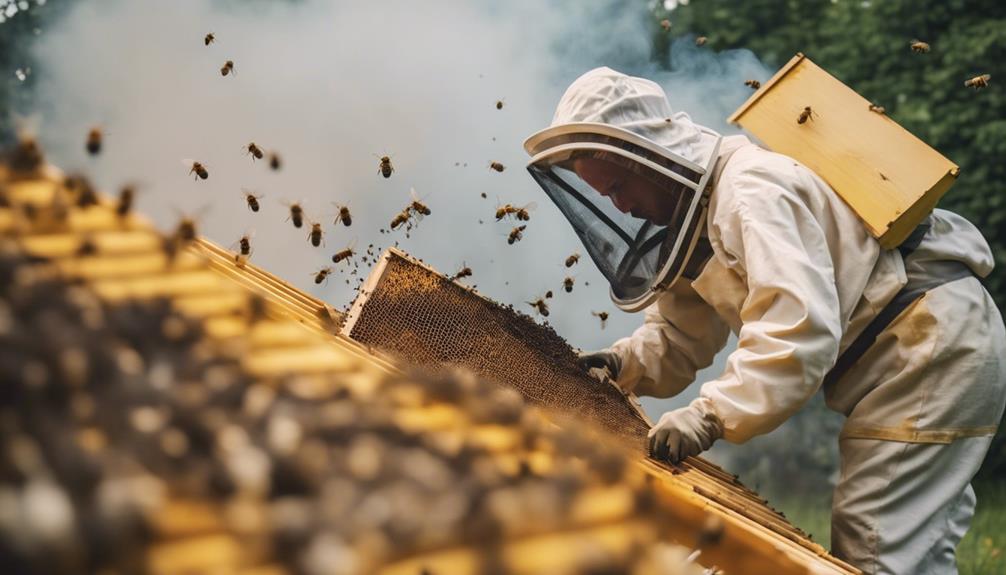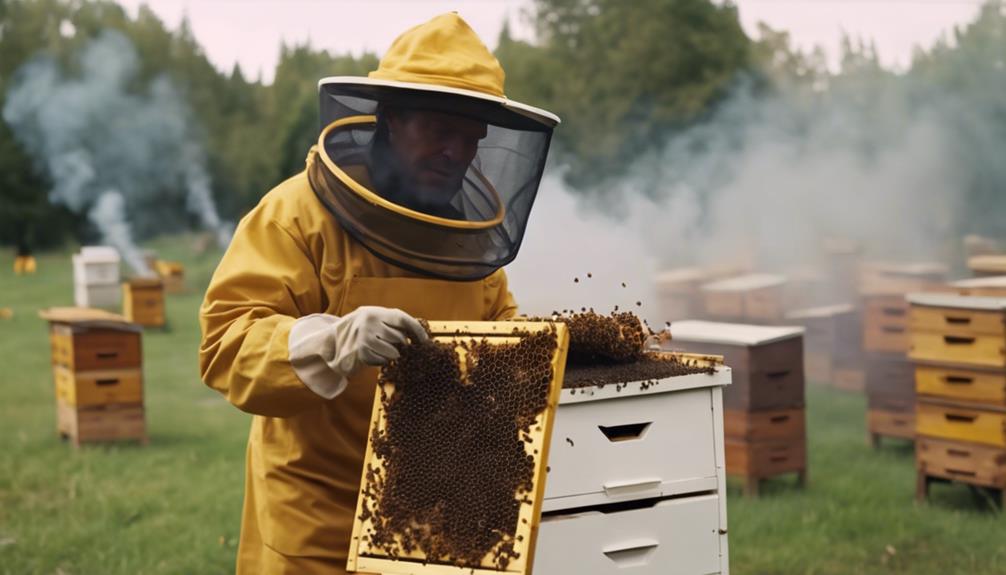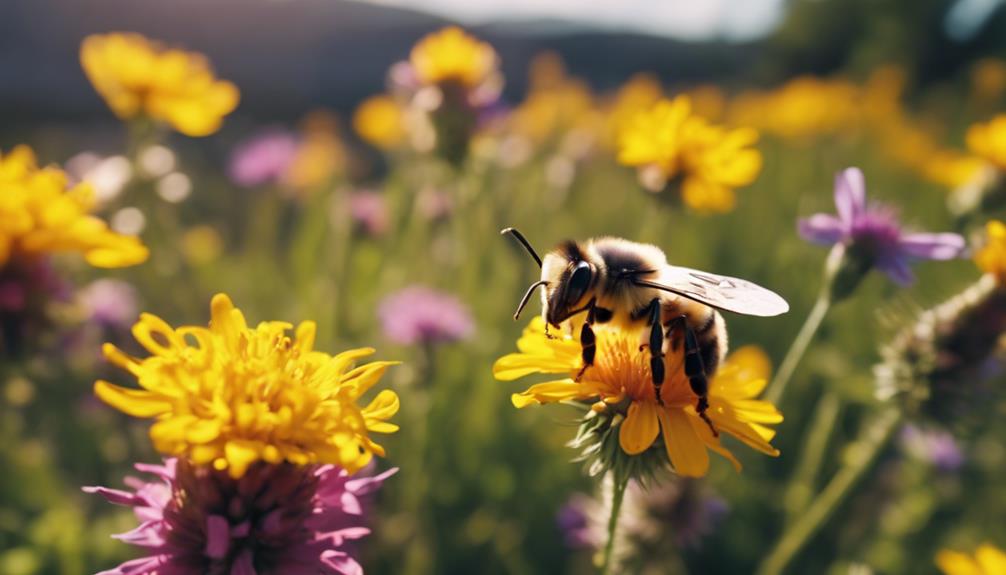Smoke can stress bees by causing significant changes in their behavior and disrupting their communication networks. When exposed to smoke, bees’ sense of smell is affected, leading to a temporary disruption in their ability to communicate effectively. Surprisingly, using smoke to mask pheromones can actually result in calmer bee behavior, with effects that wear off within 10-20 minutes. The impact of smoke on bees’ responsiveness is reversible, showing how bees demonstrate remarkable adaptability and resilience in the face of stressors like smoke. Understanding these effects is vital for beekeepers looking to manage hives effectively and guarantee the well-being of their colonies.
Main Points
- Smoke disrupts bees’ communication and behavior temporarily.
- Bees show no long-term harm from exposure to smoke.
- Smoke’s effects on bees last around 10-20 minutes.
- Bees recover swiftly after exposure to smoke.
- Smoke helps maintain hive tranquility during inspections.
Effects of Smoke on Bee Behavior
When exposed to smoke, bees undergo significant behavioral changes affecting their communication and response mechanisms. Smoke interferes with bees’ sense of smell, disrupting their usual way of signaling danger or food sources. This disruption can lead to altered behaviors, such as bees consuming honey and showing different reactions on combs.
Surprisingly, masking pheromones with smoke actually results in calmer bee behavior, impacting their stinging ability. Observations even suggest that guard bees might be among the first to consume honey when exposed to smoke.
Despite these effects, the impact of smoke on bee behavior is reversible within 10-20 minutes after exposure. It’s fascinating how something as simple as smoke can have such a profound influence on these amazing creatures and their intricate ways of communication.
Impact of Smoke on Hive Communication
When smoke enters a bee colony, it messes with the bees’ communication networks. Imagine trying to chat with your buddies at a noisy concert – that’s what it’s like for bees when smoke disrupts their pheromone signals.
They scramble for cover, delaying important messages and causing a temporary buzz of confusion in the hive.
Smoke Disrupts Pheromone Signals
Often, smoke disrupts bees’ ability to detect important alarm pheromones, hindering hive communication and coordination. Smoke reduces bees’ sense of smell, making it challenging for them to pick up cues like isopentyl acetate and 2-heptanone, vital for signaling danger. This interference hampers the transmission of alarm signals within the colony, impacting how bees alert each other.
When exposed to smoke, bees become less responsive to low levels of alarm pheromones, affecting their ability to react swiftly to threats. The disruption caused by smoke masks essential chemical messages, leading to confusion and potential disarray in the hive. Fortunately, the effects on bees’ pheromone detection are reversible within a short timeframe, typically recovering within 10-20 minutes.
Bees Seek Shelter
Upon exposure to smoke, bees instinctively seek shelter within the hive, reacting to the disruption in hive communication caused by the masking of alarm pheromones. Here are some intriguing facts about how smoke impacts bees and their behavior:
- Guard bees play an essential role in protecting the hive from potential threats, but smoke interferes with their ability to communicate effectively.
- The presence of smoke is perceived as a significant threat to the hive, prompting bees to take immediate action to safeguard the queen and the brood.
- In response to the perceived danger, bees may exhibit behaviors such as clustering together tightly or consuming honey to prepare for potential evacuation.
- The altered behavior of bees under the influence of smoke highlights the resilience and adaptability of these remarkable insects in the face of adversity.
Communication Delays Occur
Experiencing disruptions in hive communication, bees exposed to smoke encounter delays in detecting alarm pheromones. When a bit of smoke infiltrates the hive, it can throw off our ability to convey important messages effectively.
The calm bees mightn’t pick up on the signals as quickly, affecting how we coordinate activities and respond to threats. This delay in communication could mean that the release of the venom or the call for reinforcements doesn’t reach everyone in time, leading to confusion and potential disarray.
We rely on these alarm signals to keep the hive safe and functioning smoothly, so any interference, even from just a bit of smoke, can have significant consequences on our overall efficiency and well-being.
Reversibility of Smoke Effects on Bees
In regard to the effects of smoke on bees, it’s fascinating to note that these impacts aren’t long-lasting. In fact, within just 10-20 minutes, bees start to bounce back from the stress induced by smoke exposure.
Their antennae gradually regain sensitivity, and before you know it, they’re back to their buzzing business, communicating and foraging as usual.
Smoke Impact Duration
After exposure to smoke, bees show a gradual recovery in responsiveness, typically within 10-20 minutes. Here are some intriguing points about the smoke impact duration on bees:
- Bees’ ability to communicate through pheromones is disrupted by smoke temporarily.
- The bees become less likely to sting during and right after exposure to smoke.
- Smoke causes bees to focus on grooming rather than defending or inspecting their hives.
- Once the effects of smoke wear off, bee colonies quickly return to their normal routines.
Understanding the temporary nature of smoke’s impact on bees can help beekeepers manage hives effectively without causing short-term stress to these essential pollinators.
Recovery After Exposure
Upon exposure to smoke, bees swiftly recover their normal responsiveness within 10-20 minutes. The temporary communication disruption caused by smoke is reversible, allowing bees to resume their typical behavior shortly after exposure.
This quick recovery showcases the resilience of these incredible insects. Despite the initial disturbance, bees show remarkable adaptability, bouncing back to their usual state without any long-lasting negative impacts from the smoke. Observing bees returning to their daily tasks highlights their ability to overcome temporary challenges.
It’s fascinating to witness how these tiny creatures can recover so swiftly, emphasizing their strength and collective nature within the hive. The bees’ ability to recover quickly after exposure to smoke demonstrates their impressive capacity to adapt and thrive even in the face of temporary disruptions.
Use of Smoke in Calming Bees

The use of smoke in calming bees is a common practice among beekeepers to disrupt the communication and behavior of bees. Here are some intriguing facts about how this method helps manage bee colonies:
- A gentle puff of smoke interferes with worker bees’ sense of smell, making it difficult for them to detect alarm pheromones.
- By using smoke, beekeepers induce bees to engage in behaviors like preparing to leave the hive and consuming honey, which helps keep them occupied and less likely to sting.
- Cool smoke, when used in moderation, doesn’t harm bees but effectively disrupts their communication within the colony.
- The calming effects of smoke are reversible, typically lasting only 10-20 minutes after exposure.
Duration of Smokes Effects on Bees
Using smoke in calming bees has been observed to have temporary effects on their behavior, with the calming effects typically lasting around 10-20 minutes before bees resume their normal activities.
During this time, the bees’ antennae gradually regain responsiveness, allowing them to navigate and communicate within the hive effectively. The smoke also hinders the spread of alarm signals within the colony, providing a window for beekeepers to work without causing unnecessary stress.
Once the effects of the smoke wear off, the bees go back to their usual tasks, showing no long-lasting harm from the exposure. Understanding the duration of smoke’s effects on honey bees is essential for beekeepers to anticipate when the calming influence may diminish, ensuring they can handle the hives safely and effectively.
Beekeepers Perspective on Smoke

Beekeepers rely on smoke as a practical tool for calming bees and managing hive behavior effectively. In handling our buzzing friends, smoke plays an essential role in maintaining peace. Here are some insights into how we beekeepers view the use of smoke:
- Smoke is our trusty ally in preventing aggressive behavior during hive inspections.
- By disrupting alarm pheromones, smoke helps reduce the chances of stinging incidents.
- Professional beekeepers swear by smoke for its cost-effectiveness and reliability in managing bee behavior.
- Using smoke allows us to work safely around bees without triggering their alarm responses, making hive maintenance a smoother experience.
With smoke on our side, beekeeping becomes a harmonious dance with nature’s most industrious workers.
Benefits of Using Smoke in Beekeeping
Enhancing beekeeping practices, the strategic use of smoke proves invaluable in maintaining hive tranquility during inspections.
Honey bees, sensitive creatures that they are, can easily get agitated by the slightest disturbance. However, smoke comes to the rescue, acting as a shield that blocks their alarm pheromones and keeps them in a state of calm.
Picture this: a puff of smoke wafting through the air, gently reassuring the bees that all is well, allowing beekeepers to work efficiently and safely. It’s like a soothing wave washing over them, easing any tension that might arise.
Thanks to smoke, beekeepers can navigate hive inspections smoothly, ensuring both the well-being of the bees and the success of their beekeeping endeavors.
Considerations When Using Smoke in Hives

When using smoke in hives, it’s crucial to consider the timing and amount applied to effectively calm bees during inspections.
- Timing is Key: Applying smoke before opening the hive gives bees time to settle, making inspections smoother.
- Moderation Matters: Using just enough smoke guarantees bees are calm without overwhelming them.
- Watch for Reactions: Be observant of how bees respond to smoke to adjust your techniques accordingly.
- Safety First: Always use a smoker correctly and be mindful of fire hazards in the beekeeping environment.
Considering these factors when working with honey bees (Hymenoptera) and smoke can lead to successful hive management while respecting the bees’ natural behaviors.

Roger Thomas is a seasoned beekeeper and hive architect with a deep-seated passion for sustainable living. His fascination with bees has shaped his professional career, giving him practical and theoretical expertise in bee behavior, colony health, and optimal hive conditions. Roger’s technical skills shine in his bespoke hive creations that cater to the specific needs of diverse bee species, while his sustainable practices promote environmental balance and the wellbeing of the bee population.
As he continues his journey in beekeeping, Roger has become a dedicated advocate for responsible practices and an insightful educator in his field. His posts aim to inspire new beekeepers, underline the importance of sustainability, and showcase the remarkable contribution bees make to our ecosystem. Roger invites you to join him as he delves into the world of bees and the rewarding, honey-sweet art of beekeeping.


